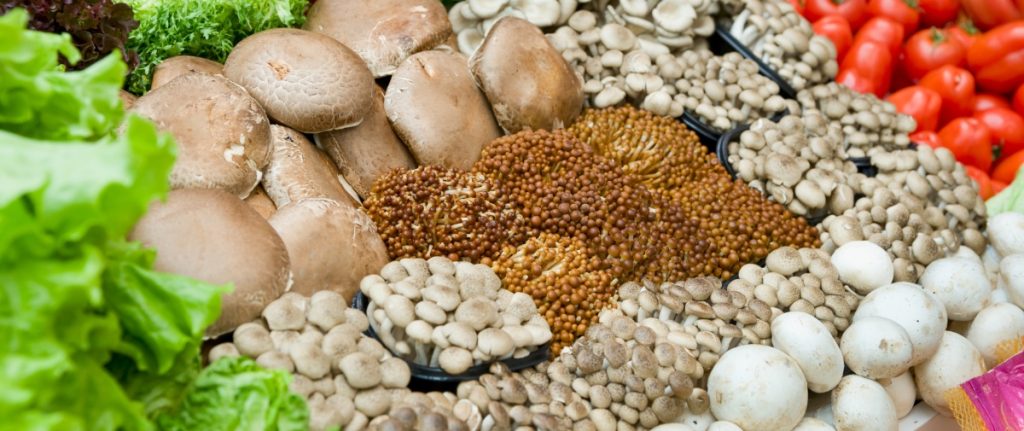Mushrooms are full of beneficial nutrients and medicinal compounds, and as people discover the health benefits they offer, they’re including them in their daily meals.
Fortunately, grocery stores have noted the increased demand and now offer a broader range of gourmet mushrooms than ever before.
But, for those new to the delights of mushrooms, the selection available in grocery stores can be a little intimidating.
Where do you start, and what is the best way to use the different mushroom species?
Read on to learn about some common grocery store mushrooms and how to make the best of them with a few easy recipes to get you started.
Common Grocery Store Mushrooms
Depending on where you live, the mushrooms at your local grocery store will vary, but you’ll usually come across these common mushrooms:
1. Button Mushrooms
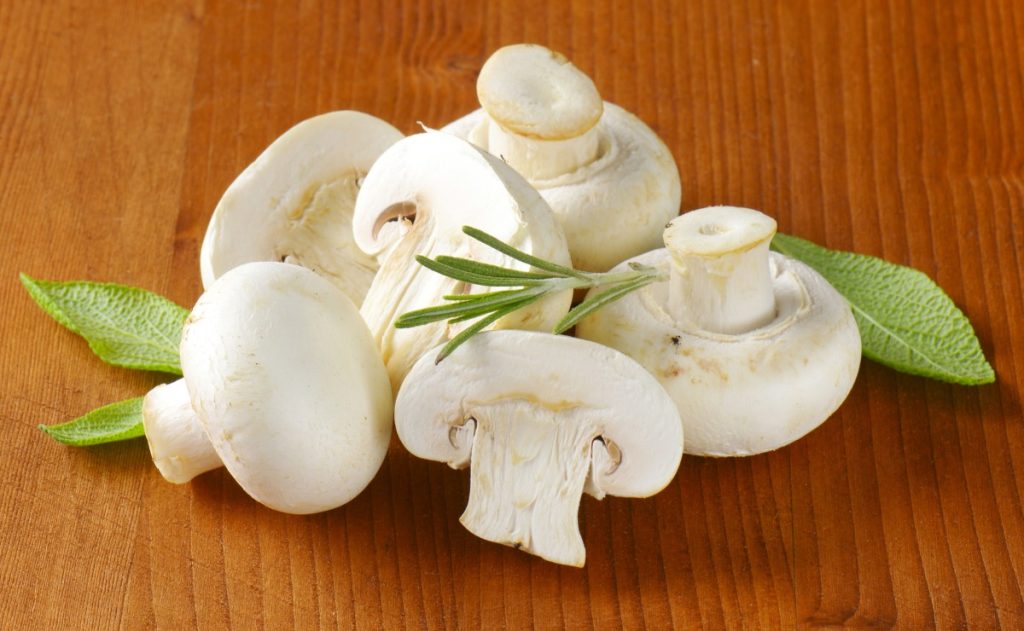
If a grocery store carries mushrooms, it will undoubtedly have button mushrooms.
Button mushrooms (Agaricus bisporus) are the most common grocery store mushrooms and one of the most cultivated and consumed mushroom species worldwide.
These mushrooms go by several names. Grocery stores may sell young, white Agricarus bisporus as button mushrooms, white mushrooms, baby mushrooms or table mushrooms.
Button mushrooms have smooth, firm white caps and short thick white stems. Underneath their caps, they have pale gills that are covered by a white veil when they’re young.
Their flavor is mild and earthy, and although very subtle when raw, it intensifies when they’re cooked.
You can use these versatile mushrooms in most dishes, and you’ll usually find them fresh, dried and canned in grocery stores.
Easy Button Mushroom Recipe
This delicious button mushroom recipe (adapted from Sunday Supper Movement) is quick and easy to make.
Simply sauté your button mushrooms in butter and olive oil with garlic and herbs to create the perfect topping or side for steak, pork or chicken.
Ingredients:
- 2 tablespoon butter
- 1 tablespoon olive oil
- 16 oz (450 g) button mushrooms
- salt and pepper
- 3 cloves of garlic minced
- 1 tablespoon flat leaf parsley chopped, plus more for optional garnish
- 1 teaspoon thyme dried
Instructions:
- Trim off damaged sections or extra long stems, then rinse your mushrooms to remove any dirt and pat dry with a paper towel.
- Add the butter and olive oil to a large pan over medium-high heat. Once the butter has melted, add the mushrooms and season with salt and pepper to taste.
- Let the button mushrooms cook for 5-7 minutes, stirring them infrequently to allow them to brown and caramelize.
- Reduce heat to medium and add garlic, thyme, and parsley. Cook until fragrant, around 1-2 minutes, mixing everything together well in the pan.
- Garnish your mushrooms with the remaining parsley and serve warm.
2. Cremini Mushrooms
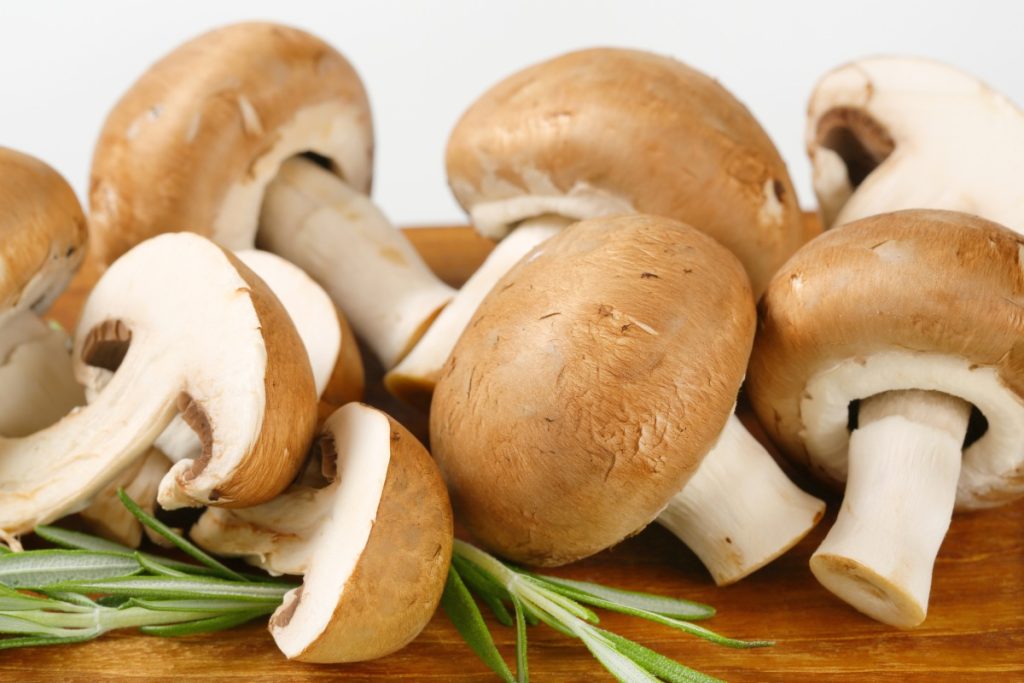
Cremini mushrooms are a brown variety of Agricarus bisporus that cultivators harvest slightly later than button mushrooms.
Their caps are brown to chestnut in color and still smooth and rounded but often more shaggy-looking than button mushrooms.
Cremini mushrooms are one of the most popular culinary mushrooms and are sometimes sold as cremino, common brown, chestnut or Roman brown mushrooms.
Grocery stores also commonly market them as baby bella, mini bella, portobellini or baby portobella mushrooms.
They have a slightly bolder, earthier taste than button mushrooms but are still subtle and mild compared to other gourmet wild mushrooms.
Their delicate texture is similar to button mushrooms, and, like button mushrooms, they’re very versatile and perfect for introducing babies to the taste and texture of mushrooms.
Roasted Cremini Mushroom Recipe
We enjoy sauteed mushrooms, but these roasted cremini mushrooms (recipe adapted from a couple of cooks) are tender, meaty and juicy, and just as quick and easy to make.
Ingredients:
- 1 pound (450 grams) of cremini mushrooms
- 2 tablespoons olive oil
- ¼ teaspoon garlic powder
- ½ teaspoon salt
- 1 tablespoon of chopped fresh herbs such as chives, oregano, basil or thyme or ½ a tablespoon of dried herbs
Instructions:
- Preheat the oven to 450°F (230°C).
- Clean your cremini mushrooms and pat them dry.
- Cut the mushrooms in half, not slices, as mushroom halves stay juicy and don’t shrink as much as mushroom slices when roasted.
- In a large bowl, toss the mushroom halves with the olive oil, garlic powder and salt.
- Line a baking sheet with parchment paper and spread the mushrooms in a single layer on top.
- Bake for 10 to 12 minutes until the mushrooms are tender.
- Serve warm, topped with fresh herbs.
3. Portobello Mushrooms
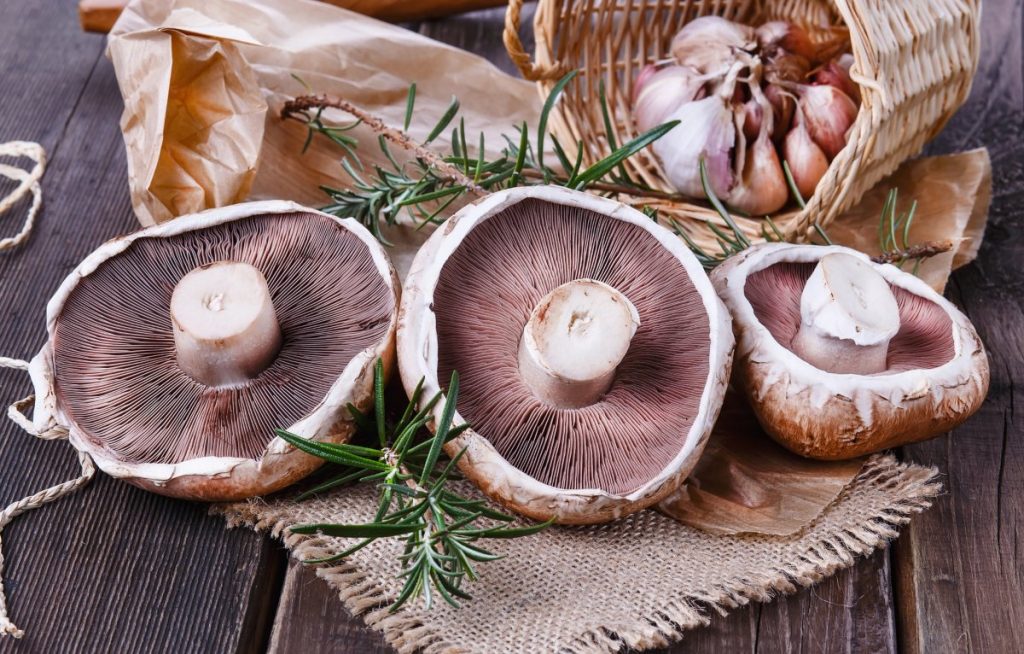
Portobello mushrooms are mature Agricarus bisporus mushrooms whose large, dark brown caps have fully opened, exposing their brown gills.
In some grocery stores, you’ll find these mushrooms marketed as portabella, ports or giant cremini.
They are much bigger than button and cremini mushrooms, and as they have had more time to grow and lose moisture, they have a meaty steak-like texture and richer flavor.
Their size and texture make them popular as a meat substitute, and they’re often used as vegan or vegetarian burger patties or stuffed with different ingredients and baked.
Caprese Stuffed Portobello Mushroom Recipe
These delicious stuffed portobellos make a great side dish, but they’re so filling you could even use them as a main dish.
There are loads of ways to stuff portobello mushrooms, but this wonderful recipe (adapted from Cafe Delights) combines the wonders of garlic butter with a Caprese-style stuffing and sweet balsamic glaze.
Ingredients:
For the garlic butter:
- 2 tablespoons butter
- 2 cloves garlic, crushed
- 1 tablespoon freshly chopped parsley
For the mushrooms:
- 5-6 large Portobello Mushrooms, stem removed, washed and dried thoroughly with a paper towel
- 5-6 fresh mozzarella cheese balls, sliced thinly
- 1 cup grape or cherry tomatoes, sliced thinly
- fresh basil, shredded to garnish
For the balsamic glaze: (You can use store-bought glaze or this recipe)
- 1/4 cup balsamic vinegar
- 2 teaspoons brown sugar (Optional)
Instructions:
- Put the oven shelf in the middle of your oven and preheat the oven to grill/broil settings on high heat.
- Combine all the garlic butter ingredients in a small saucepan (or microwave-safe bowl), and melt until the garlic is fragrant.
- Brush the bottoms of each mushroom with garlic butter and place them, buttered side down, on a baking tray.
- Brush any remaining garlic butter over the inside of each cap and fill each mushroom with mozzarella slices and tomatoes.
- Grill/broil the stuffed mushrooms until the cheese has melted and is golden in color (about 8 minutes).
- To serve, top with fresh basil and drizzle with balsamic glaze.
Prepare the balsamic glaze while the mushrooms are in the oven.
- Combine sugar (if using) and vinegar in a small saucepan over high heat and bring to a boil.
- Reduce heat to low and leave to simmer for 5-8 minutes or until mixture has thickened and reduced to a glaze. (If not using sugar, allow to reduce for 12-15 minutes on low heat).
4. Shiitake Mushrooms
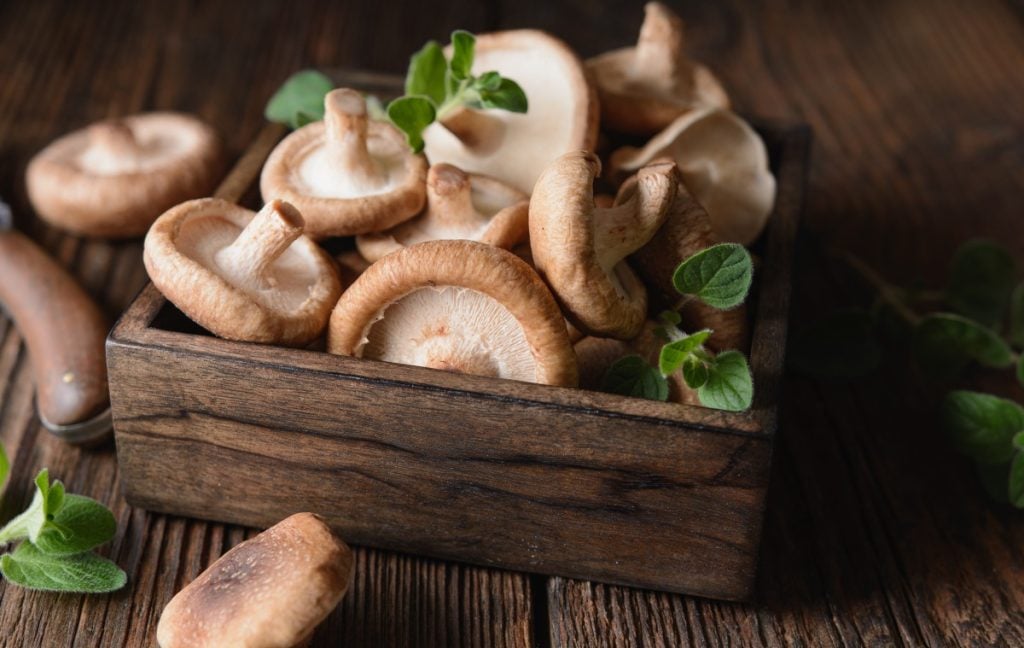
Shiitake mushrooms are delicious edible mushrooms native to East Asia but cultivated worldwide and found fresh and dried in many grocery stores.
Although commonly sold as shiitake mushrooms, they have several other names, including Chinese black, golden oak, oriental black, black forest or black mushroom.
Shiitake are easily recognizable with dark brown umbrella-shaped caps and off-white gills.
Their cream or tan-colored stems are thinner and tougher than cremini or portobello stems.
Shiitake mushrooms tend to be more expensive than button, cremini or oyster mushrooms but are sought after for their rich, intense flavor and aroma.
People describe the shiitake’s taste as earthy, buttery, meaty, woodsy or slightly smoky. And dried shiitakes have an even more intense umami taste and flavor.
Commonly used in Asian cuisine, shiitake mushrooms are a popular ingredient in stir-fries, risottos and soups.
Shiitakes have a firm texture, making them a great meat substitute and ideal for grilling, roasting or sauteing.
People use them to make vegetarian burgers or to replace ground beef in lasagna or spaghetti bolognese.
Easy Shiitake Mushroom Recipe
This easy recipe (adapted from Simple Fit Vegan) takes 10 minutes to make and only has 3 ingredients, but the result is mouth-wateringly delicious shiitake mushrooms.
The sesame oil adds a ‘toasted’ nutty flavor which combines perfectly with the salty soy sauce to create an unforgettable meal.
Ingredients:
- 1 cup shiitake mushrooms cut lengthwise into strips
- 1 tbsp sesame oil
- 2 tbsp soy sauce
Instructions:
- Preheat a non-stick skillet on medium heat.
- Add the shiitake mushrooms, sesame oil, and soy sauce.
- Sauté for about 3 minutes until the mushrooms are soft. Shiitake mushrooms cook quickly.
- Serve on their own or with soba noodles and fresh arugula.
5. Oyster Mushrooms
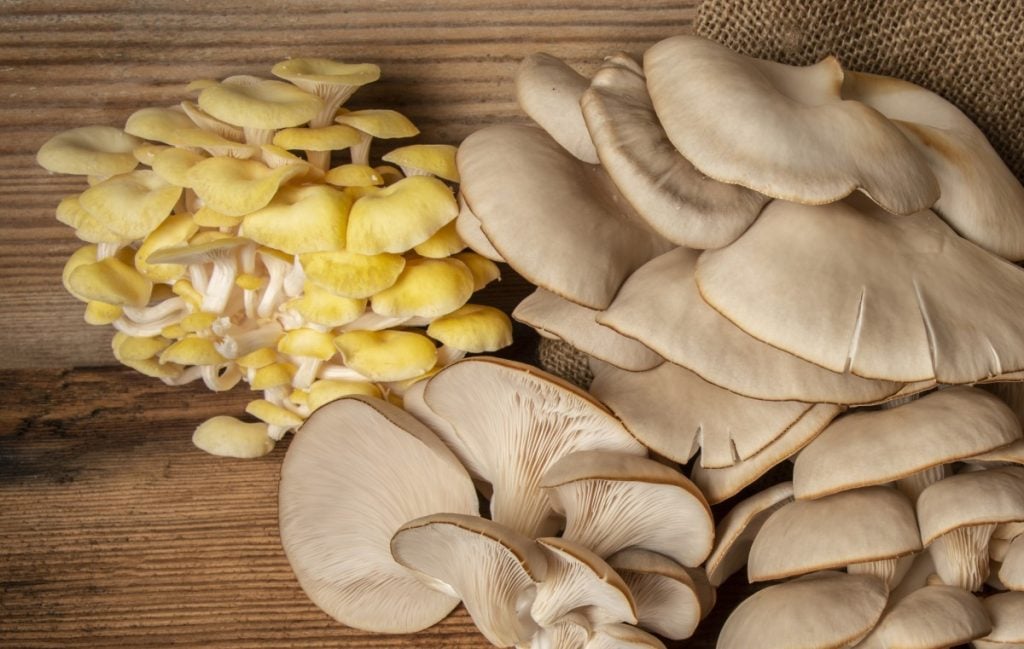
Oyster mushrooms are some of the most consumed mushrooms in the world and are often available fresh in grocery stores.
If you don’t find fresh oysters on their own, they’ll often be available as part of a gourmet mushroom mix.
For some people eating oyster mushrooms is a big step as they look nothing like the familiar button, cremini or portobello mushrooms.
But, they have a mild, slightly sweet flavor with earthy notes and make a great transition mushroom from cremini and portobellos to other more exotic gourmet mushrooms.
Oyster mushrooms have smooth, oyster or fan-shaped caps, usually 2-10 inches (5-25 cm) across, with short stems.
Their gills are white and decurrent, meaning they’re attached to and run down the stem.
The oyster mushrooms in grocery stores are typically light gray or grayish-brown in color.
But oyster mushrooms also come in several other colors, including blue, yellow and pink and they all have slightly different flavors, although still subtle and mild.
Although not common in grocery stores, you’ll often find these colored oyster mushrooms at farmer’s markets.
Sauteed oyster mushrooms on toast is one of our favorite ways to enjoy these mushrooms. Take a look at our oyster mushroom recipes article for this easy recipe and more.
6. Porcini Mushrooms
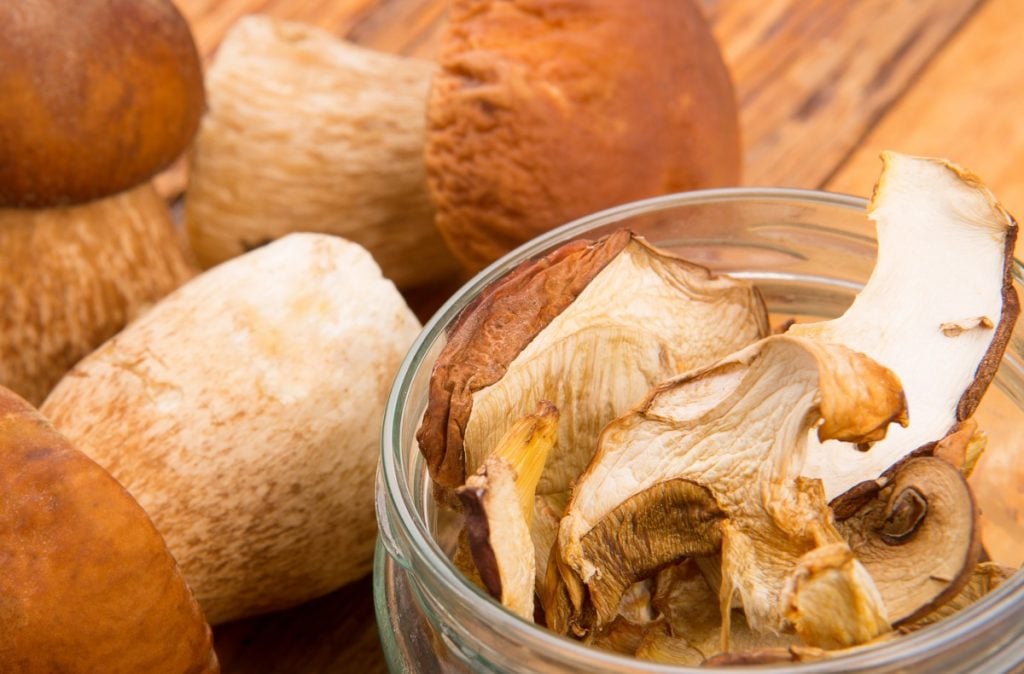
Porcini mushrooms are particularly common in Italy but grow wild in forests throughout the northern hemisphere.
They have thick creamy-white stems and fat, round, brownish caps that flatten as they mature.
Porcini goes by several names, including king bolete, penny bun, cèpe (in French) and Steinpilz (in German), and are sought after by chefs for their meaty texture and distinct flavor.
As porcini mushrooms are mycorrhizal and challenging to cultivate, fresh porcini mushrooms are highly sought after and often not available in grocery stores.
But dried porcinis are usually available in grocery stores, and you may also find canned porcini mushrooms.
Porcini have stronger, wilder flavors than many cultivated mushrooms and add slightly creamy, earthy, nutty flavors to soups, stews, sauces and stuffing.
To rehydrate dried porcini, steep them in warm water for about half an hour until they soften and expand. Once rehydrated, you can use your porcini in most recipes that call for mushrooms.
Keep the liquid you used to rehydrate them, as this is full of mushroom flavor, and you can use it to make risotto, sauces or broths.
Woodland or Gourmet Mixes
Apart from the common mushrooms above, many grocery stores also carry a mix of exotic gourmet mushrooms for more adventurous shoppers.
They market these under several names, including exotic mushroom selection, extra special mixed mushrooms, woodland mushrooms, wild gourmet mix and gourmet blend.
Although stores call these mixes wild or woodland mushrooms, they often contain commonly cultivated varieties like oyster, shiitake, maitake and enoki mushrooms.
Some mixes include difficult-to-cultivate, wild mycorrhizal mushrooms like chanterelles, morels or porcini.
But most contain cultivated gourmet mushrooms marketed as wild mushrooms.
This is not necessarily bad, as cultivated mushrooms don’t have the danger of wrong identification and are usually bug-free and cleaner than foraged wild mushrooms.
You can use woodland or gourmet mushroom mixes in most recipes that call for mushrooms.
By combining different gourmet or wild mushrooms in the same meal, you get added depth of flavor, contrasting textures and a deeper, richer umami taste.
Most woodland or gourmet mixes include oyster or shiitake mushrooms and one or more of the mushrooms below:
7. Eryngii Mushrooms
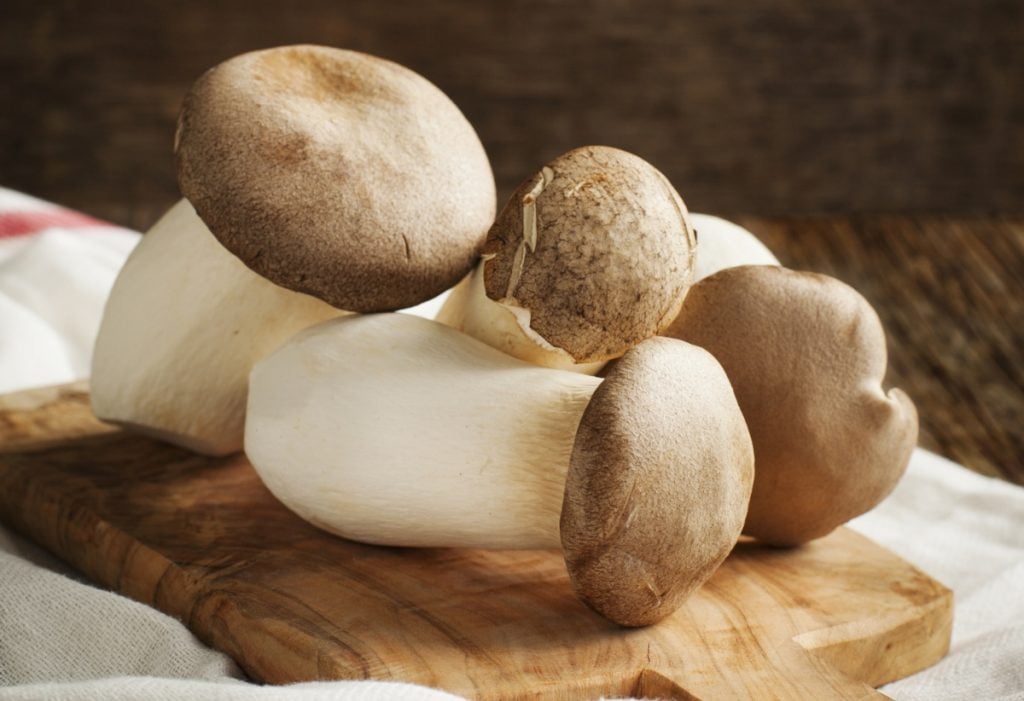
Eryngii or king oyster mushrooms are a delicious edible species with thick stems that are often nearly as wide as their thin, flat caps.
These mushrooms have several names, including eryngii, king oyster, king trumpet, royal trumpet, French horn and scallop mushrooms.
They’re frequently included in gourmet mushroom mixes for their meaty texture and unique, intensely umami taste that’s hard to pin down.
Most people describe their taste as earthy, woody and slightly nutty, but others find them savory and meaty with seafood-like flavors, and some detect subtle anise or licorice undertones.
8. Maitake Mushrooms
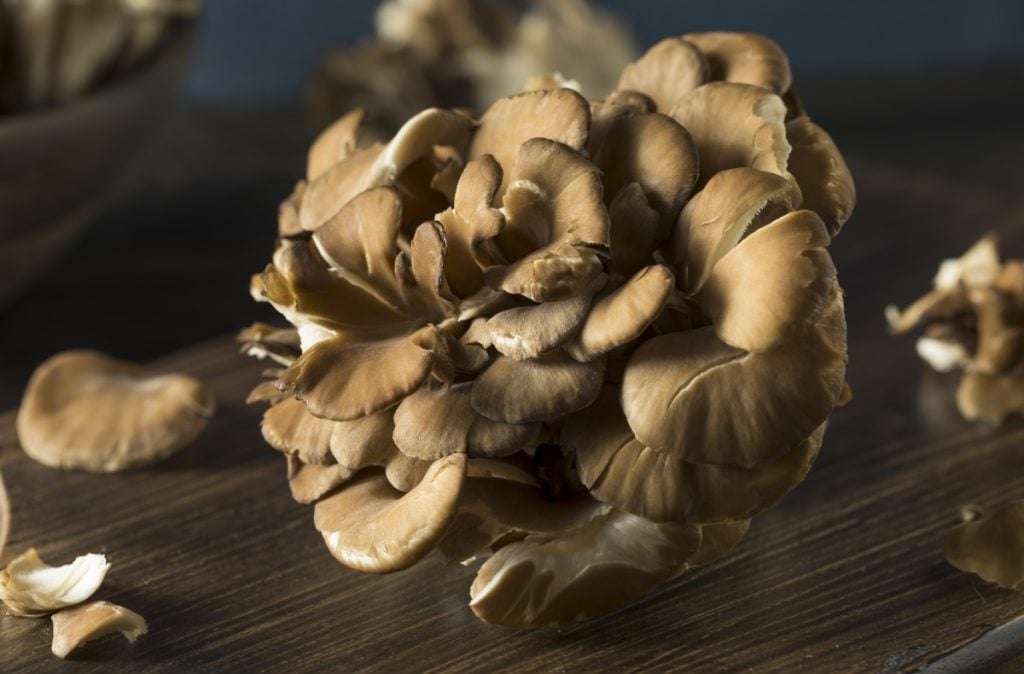
Maitake mushrooms have many names, including hen of the woods, sheep’s head, ram’s head, the signorina mushroom, dancing mushroom and kumotake (cloud mushroom).
They grow in clusters and have flattened brown caps with delicately feathered edges and pores, instead of gills, that they use to release their spores.
Maitake mushrooms have a mildly spicy, peppery flavor and unique, delicate texture that most people enjoy, even those who don’t usually like mushrooms.
These mushrooms are very versatile, and you can enjoy them sauteed, roasted, deep fried or added to pasta, risotto or eggs.
9. Shimeji Mushrooms

There are several varieties of shimeji mushrooms, but the ones most commonly found in gourmet mushroom mixes are white (bunapi-shimeji) or brown (buna-shimeji).
Although native to East Asia, they’re now cultivated in Europe, Australia and North America and available in many grocery stores.
Shimeji mushrooms grow in clusters with small round caps and long, slender stems connected at the base.
In the wild, shimeji are often found growing on dead and decaying beech trees, which is why they’re also known as beech mushrooms.
Raw shimeji are tough and bitter, but when cooked, they have a sweet, nutty flavor and slightly crunchy texture, making them perfect for stir-fries, soups, stews and sauces.
10. Enoki Mushrooms
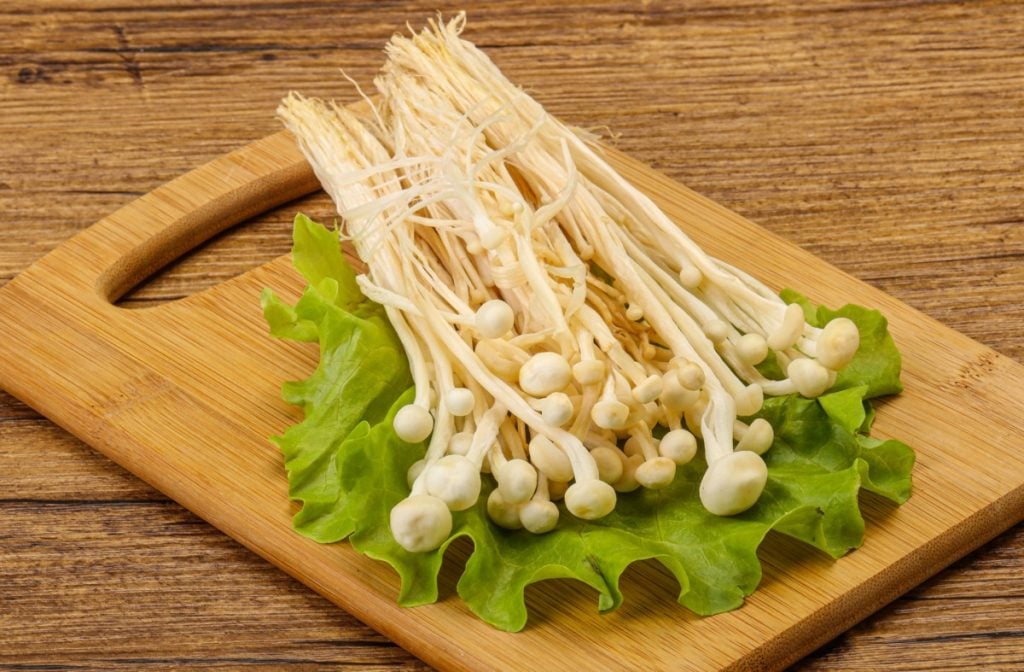
Also called futu, enokitake, golden needle or winter fungus, enoki mushrooms grow in large clusters of exotic-looking mushrooms with long thin stems and small caps.
Their distinctive appearance makes them very easy to spot in grocery stores, where you’ll find them fresh or canned.
We recommend eating fresh enoki to fully enjoy their mild, delicate flavor and firm, slightly crunchy texture.
Commonly used in Asian cuisine, they’re quick and easy to cook and go well in soups, stir-frys, hot pots and noodle dishes like ramen.
But you can also eat them raw and fresh enoki are often used to add a nice crunch to salads.
11. Chanterelle Mushrooms
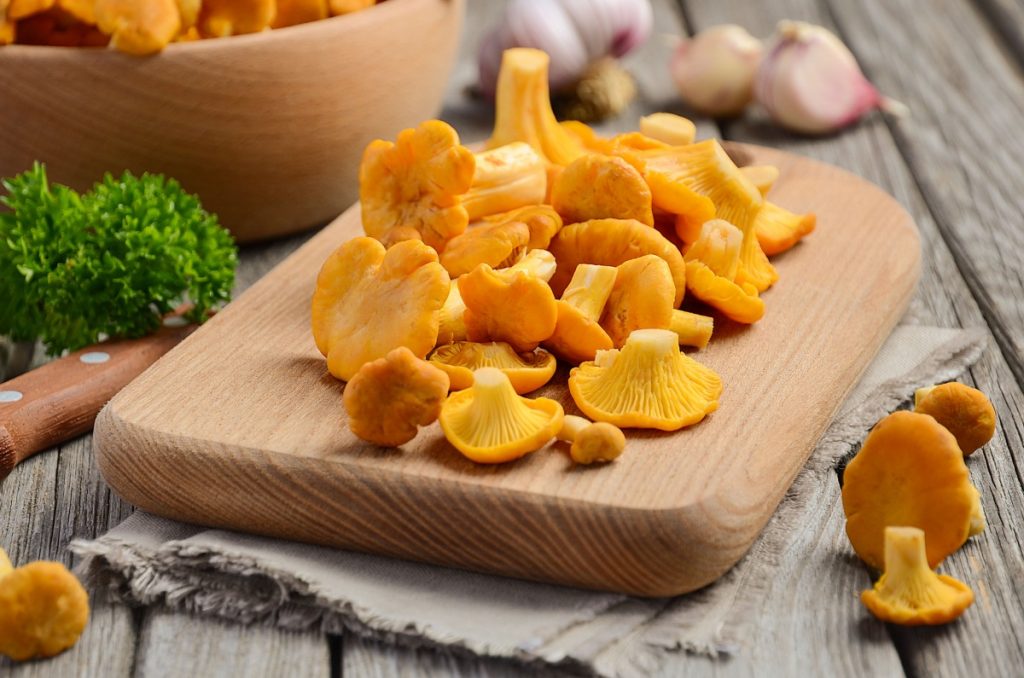
Like many wild mushrooms, chanterelles have stronger flavors than cultivated mushrooms and are one of the most popular wild mushroom species found in grocery stores.
Because chanterelles are challenging to cultivate, they’re usually collected in the wild.
As a result, fresh chanterelles are only available in season, but you’ll find dried chanterelles year-round.
Chanterelles are also called egg mushrooms, golden or yellow chanterelles, girolle or pfifferling and are known for their bright color and mild peppery taste that goes well with eggs.
When first picked, chanterelles have a fruity apricot or peach-like aroma, which is deceptive as their flavor is not fruity.
People describe the taste of chanterelles as earthy, woodsy and mildly peppery.
Sauteing is the best way to appreciate a chanterelle’s flavor and delicate texture, and they’re used to add rich flavor to stir-fries and pasta dishes.
Best Time to Buy Grocery Store Mushrooms
Autumn is the fruiting season for many types of mushrooms, and although growers cultivate common grocery store mushrooms year-round, you’ll find more fresh wild mushrooms in grocery stores in autumn.
And, a visit to your local farmer’s market in autumn will offer an abundance of locally foraged and cultivated mushroom species.
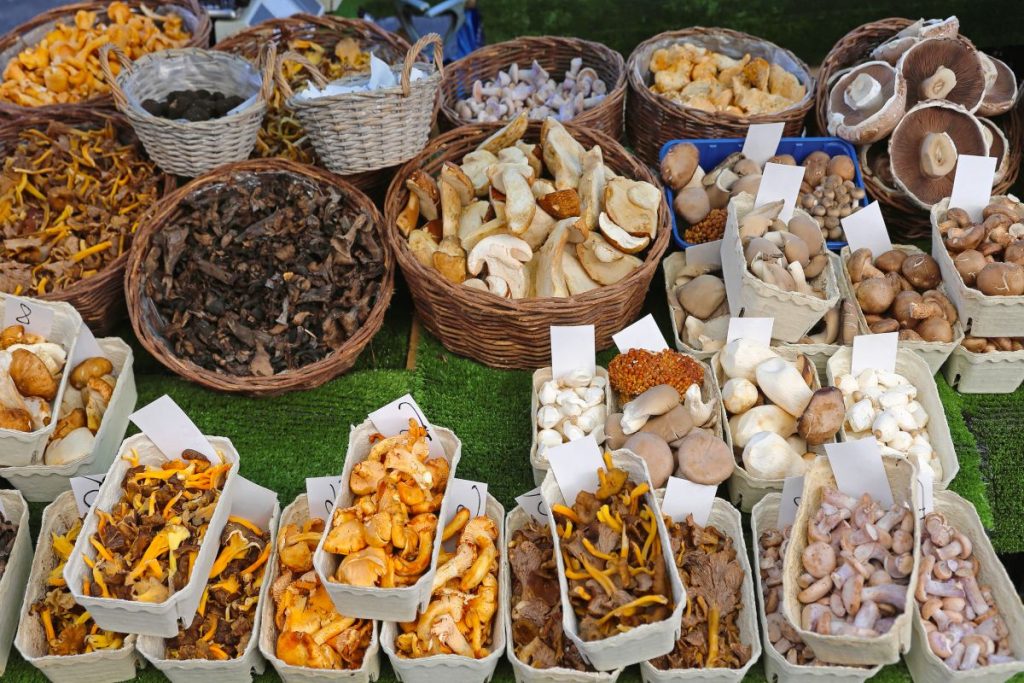
Farmers Market vs Grocery Store Mushrooms
There is a lot of debate about whether it’s cheaper to buy mushrooms at a farmer’s market or grocery store.
This is understandable, and the answer is not straightforward. There are a lot of factors to consider, and farmer’s markets often offer different mushroom species to grocery stores.
As common grocery store mushrooms are usually farmed commercially on a large scale, economies of scale should bring prices down.
But farmers often transport these mushrooms long distances to get them to stores which adds to the cost of the end product.
And then, of course, there’s the grocery store’s markup, as they also need to make some money on the mushrooms.
You would expect to pay less at farmer’s markets because you’re cutting out the middleman, but sometimes this is not the case.
Many gourmet mushrooms sold at farmer’s markets are organically grown or fussier mushroom species that need special conditions and close monitoring.
This involves more work and increases the price of the mushrooms.
And when considering popular but hard-to-come-by mushroom species, demand will increase the price.
Most people think that as mushrooms grow on substrates of natural organic materials, they’re all organic.
But, large-scale commercial mushroom production is not always organic as growers add fertilizers and nutrients to the substrate and use chemicals to keep the mushrooms bug free.
One of the benefits of forming a relationship with a local mushroom farmer at your nearest farmers market is that you’re assured the mushrooms are freshly picked and organic.
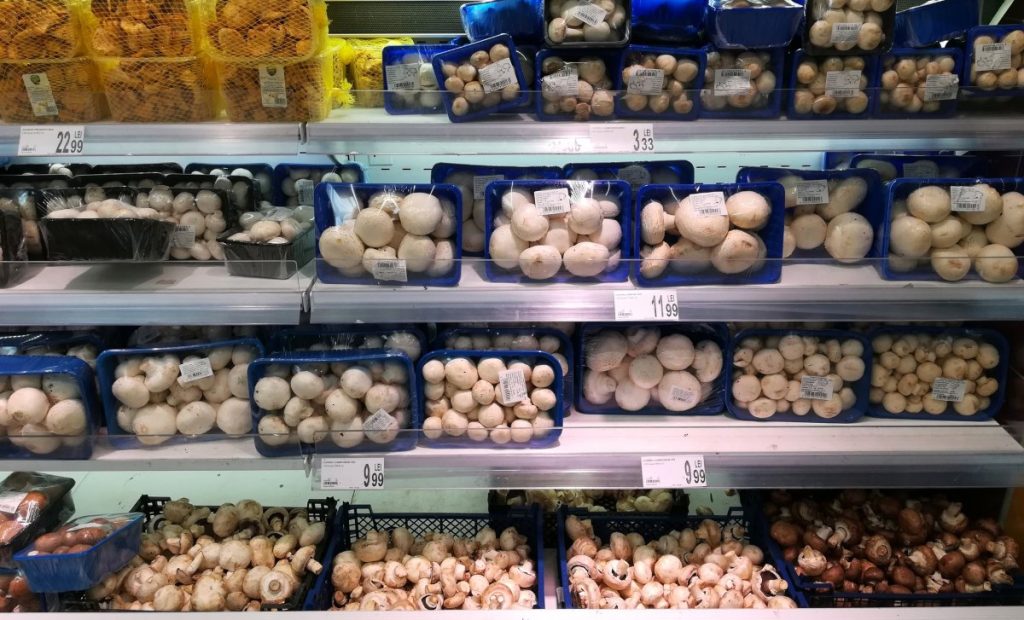
How to Select the Best Grocery Store Mushrooms
You’ll need to use your senses to find the freshest possible grocery store mushrooms.
Here are some of the things you should look for:
- Young mushrooms – The best time to harvest most mushroom species is before the caps uncurl and flatten out. Look for mushrooms with the edges of their caps still curled under.
Our article on harvesting mushrooms has more information on the best time to harvest mushrooms and what to look for.
- Smooth, dry mushrooms – The surfaces of the caps and stems should be free of blemishes or bruises, and avoid any mushrooms that look slimy.
- Undamaged mushrooms – Mushrooms that have broken caps may have been handled roughly during harvesting or transport, reducing their shelf life.
- Firm, plump mushrooms – Mushrooms that look wrinkled and dried out are already getting old and won’t last much longer.
- Mild-smelling mushrooms – Fresh mushrooms have a mild earthy smell that you can usually only smell when they’re close to your face.
If grocery store mushrooms have a strong smell, evident from a distance, they have gone bad.
Our article, “How to Tell if Mushrooms are Bad: The Telltale Signs,” has more information to help you select the best grocery store mushrooms.
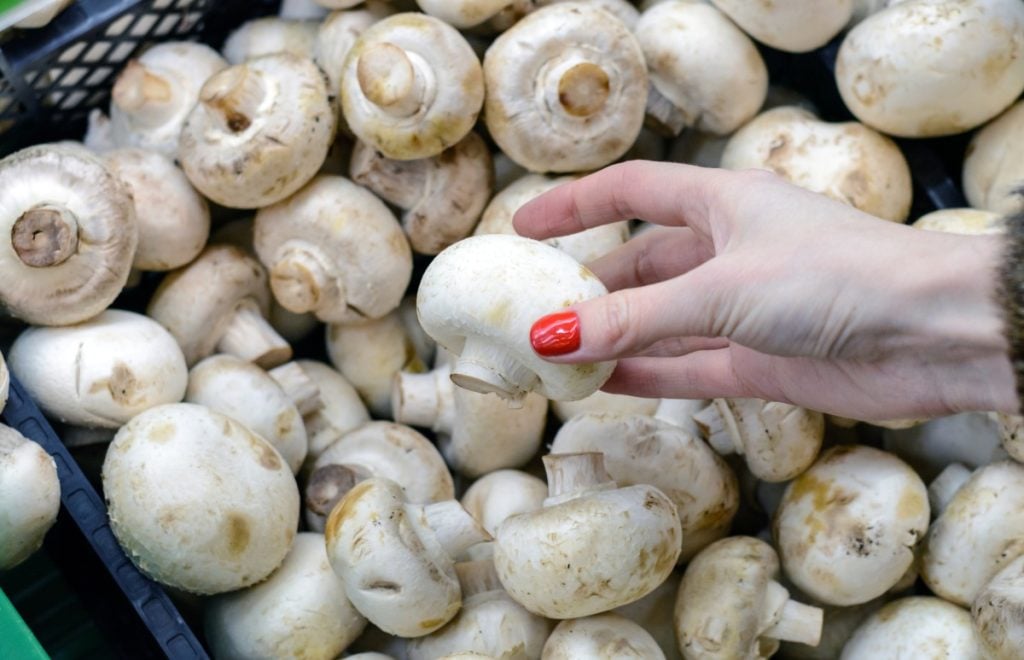
How to Store Your Mushrooms
Most fresh mushrooms have a short shelf life and won’t last long after harvesting before they begin to go bad.
A common question people ask is, “how long do mushrooms from the grocery store last?”
This is not always easy to answer as you may not know when the farmer harvested mushrooms or how long it took them to get to the store.
Generally, it’s best to use fresh grocery store mushrooms as soon as possible after buying them.
But, if you’ve selected firm, smooth mushrooms and stored them correctly, they could last up to 7 days in the fridge.
If you stumble across a deal you cannot resist and end up with more mushrooms than you can use in a week, you’ll need to use long-term preservation methods.
You can preserve your fresh mushrooms for later use by freezing, pickling or drying them.
Our article on how to store mushrooms has more information on the best way to store your mushrooms so they last longer.
Frequently Asked Questions About Grocery Store Mushrooms
If you’re slightly mycophobic or trying mushrooms in meals for the first time, you may have some questions.
Below are some frequently asked questions about grocery store mushrooms:
Q. Where are mushrooms found in the grocery store?
Although mushrooms are fungi and have their own kingdom, they’re treated as vegetables in grocery stores.
This means you’ll find fresh mushrooms in the produce section with the other fresh vegetables and canned mushrooms in the canned goods aisle with other canned vegetables.
Some grocery stores also sell frozen mushrooms, and you’ll find these in the freezer together with other frozen vegetables.
Q. Where are dried mushrooms in the grocery store?
The location of dried mushrooms varies from store to store, but you’ll usually find them in one of these spots:
- In the fresh produce section, near the fresh mushrooms or close to the garlic and shallots
- In the condiments and canned vegetable aisles
- In the pasta and grain aisles as they’re sometimes placed near ingredients commonly cooked with them.
- In the dried and bulk foods aisle
Q: What are the white mushrooms in the grocery store?
The white mushrooms in the grocery store are Agaricus bisporus, one of the most widely cultivated and consumed mushroom species worldwide.
Commonly sold as button or white mushrooms, their mild flavor and delicate texture make them ideal for people trying mushrooms for the first time.
Q. Are grocery store mushrooms all the same?
No grocery store mushrooms are not all the same.
And although button, cremini and portobello mushrooms are all the same species, most grocery stores offer a range of fresh and dried mushrooms.
Fresh gourmet mushrooms like oysters and shiitakes are frequently available in grocery stores and have become some of the most consumed mushrooms worldwide.
And many grocery stores also offer mixed wild or exotic mushrooms as well as dried porcini and shiitake mushrooms.
Q: Can dogs eat mushrooms from the grocery store?
Yes, dogs can eat small quantities of grocery store mushrooms like button, cremini, portobello, shiitake or oyster mushrooms.
For more information on dogs and mushrooms, take a look at our article, “Can Dogs Eat Mushrooms? Learn What’s Safe for Your Pet.”
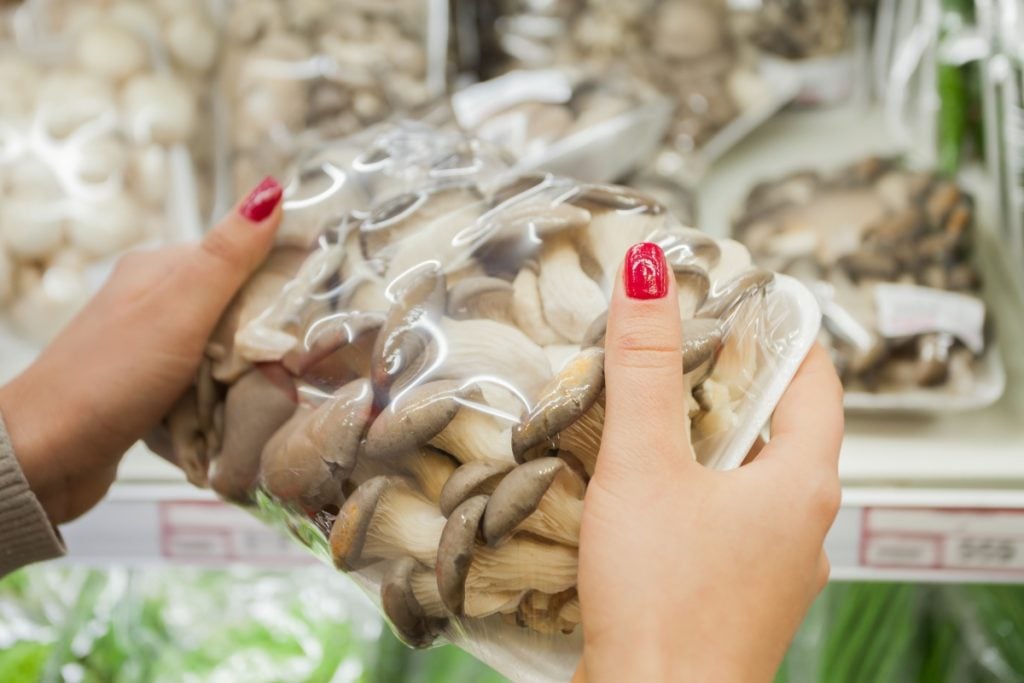
Final Thoughts
Grocery stores have responded to the increased interest in mushrooms and now offer a broader range of fresh gourmet mushrooms.
But, although grocery store mushrooms are usually fresh and safe to consume, you never know exactly when they were harvested or how far they’ve traveled to get to the store.
One of the best ways to have an ongoing supply of delicious fresh mushrooms is to grow your own at home.
Although it may sound intimidating, growing mushrooms at home is easier than you may think.
We recommend first-time mushroom growers start with easy-to-grow oyster mushrooms and use a mushroom grow kit to get quick results.
To learn more about growing mushrooms, visit our Mushroom Growing Hub or sign up for our introductory course on growing oyster mushrooms.
